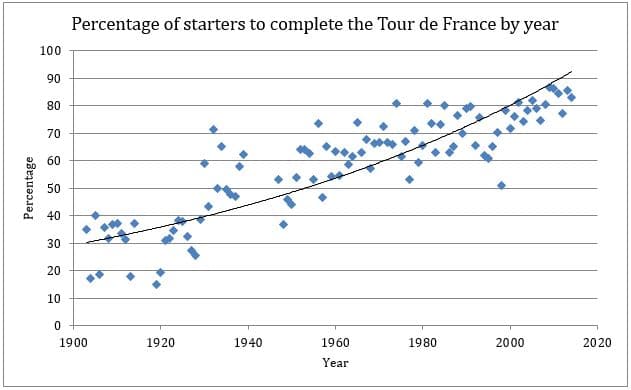With some big name withdrawals, including two yellow jersey holders in Fabien Cancellara and Tony Martin, this year’s Tour has seen the usual rhetoric around safety. BMC’s manager, Jim Ochowicz, has called for smaller pelotons while riders and observers comment on the stress of the first week with its high speeds, cobbles and ‘road furniture’.
Some have tackled the question of whether the Tour is getting more dangerous; not surprisingly, it’s not really possible to say. The most common approach when attempting to answer this question is to look at abandonments but while we know how many riders withdraw, the reasons why are not publicly available.
As the graph below shows, what can be confirmed beyond doubt is the percentage of the peloton surviving all the way to the Champs-Élysées is increasing.

So, as well as crashes, why do cyclists abandon the race? An interesting way to explore this question is to look at some outliers.
The most extreme of these is the 1919 edition when less than 15% of the 67 starters finished. This was the first Tour since the end of the First World War. France’s war-ravaged road system led to many broken frames and punctures and, ultimately, abandonments. Not surprisingly, the winner’s average speed of 24 km/h is the slowest recorded. On the plus side, if you finished, you were top ten.
The infamous 1998 edition also stands out with only 50% of the field finishing. This of course was the year that Festina soigneur Willy Voet was found by custom police to be carrying 234 doses of performance enhancing drugs, including EPO, testosterone and amphetamines. After Festina were forced to withdraw, suspicion around TVM led them to abandon. Banesto, ONCE and Risso Scotti also left the race in solidarity. As an aside, Marco Pantani won that edition as well as that year’s Giro d’Italia, making him the last man to successfully complete the Giro-Tour double (a feat Contador is attempting this year). Pantani tested positive to EPO when his 1998 Tour samples were retroactively tested in 2004 (along with 44 out of 60 other samples).
This year hasn’t seen such widespread scandal but there have been some riders making headlines for the wrong reasons. Following in the footsteps of Tom Boonen in 2008, Luca Paloini was kicked out of the race for a cocaine positive. This seems a stupid mistake rather than anything more sinister.
A slightly more comical doping-related expulsion occurred in 1978. Michel Pollentier had just won the stage to Alpe d’Huez and taken the yellow jersey. However, he was expelled when he was found to be carrying someone else’s urine in a condom under his armpit at the doping control. The condom was connected to a tube, which ran down his back and between his legs.
And while some riders get expelled, others occasionally have no intention of finishing. The most infamous of these is Mario Coppolini who, despite winning 12 stages in his six starts never made it to Paris. He was the epitome of a sprinter who did not like to climb. He got his winning done early and then looked for any excuse to leave the race. In 1995, he tried to induce sickness by turning up the air-conditioning in his room. Unsurprisingly, these antics did not endear him to the Tour organisers.
So while we can’t say whether or not the race is getting more dangerous and even though an increasing percentage of the peloton is finishing the race, there is little doubt that riders will continue to be forced out of the race for reasons weird, wonderful, stupid and strange.
By Laurence Guttmann

